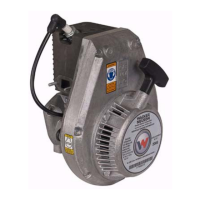Carburetor Basics WM 80 Repair
56 wc_tx000522gb.fm
See Graphic: wc_gr002892
Inlet Needle Valve:
The inlet needle valve
(e) controls fuel flow into the fuel chamber. This
valve is operated by a second diaphragm called the control diaphragm
(f). The control diaphragm is activated by the vacuum created when air
moves past the venturi (g) of the carburetor throat. A vent (h) to the
atmosphere provides the air pressure differential needed to create the
vacuum. The vent can be direct to outside the carburetor or it may be
upstream of the discharge ports through an orifice drilled in the
carburetor body. The vacuum draws the control diaphragm towards
the carburetor throat and in turn opens the inlet needle valve allowing
fuel into the fuel chamber
(i). Suction at the engine intake draws fuel
out of the fuel chamber through the discharge ports
(j) into the
carburetor throat. As the fuel in the chamber is used up, atmospheric
pressure pushes in on the opposite side of the diaphragm pushing it
towards the throat of the carburetor. This diaphragm action lowers the
inlet needle valve and allows fuel to fill the fuel chamber. The fuel
pushes the diaphragm away from the carburetor throat and in turn
closes the inlet needle valve. In actual practice, the inlet needle valve
assumes an averaging position where the amount of fuel entering
exactly replaces the amount being used.
wc_gr002892
e
i
g
f
j
h

